Intermarkets' Privacy Policy
Donate to Ace of Spades HQ!
aceofspadeshq at gee mail.com
Buck:
buck.throckmorton at protonmail.com
CBD:
cbd at cutjibnewsletter.com
joe mannix:
mannix2024 at proton.me
MisHum:
petmorons at gee mail.com
J.J. Sefton:
sefton at cutjibnewsletter.com
Surprise: The "Reporter" Who Leaked and Whined That Her Hit-Piece Got Held Up Turns Out to Have a History of Batty Leftwing Propaganda Pieces
Is This Something?
Communist Cuba "On Edge of Collapse" Due to Trump's Oil Embargo of Cuba's Key Ally Venezuela
Epstein Files Reveal Bill Clinton Cavorting With Very Young Women on Pedo Island; Democrat Flacks and Leftwing Media -- But I Repeat Myself-- Claim Trump Is "Curating" the Photos to Make Slick Willy Look Bad
AGAIN: Violent Deranged Homeless Man, Set Free By Leftwing Judges Over and Over Again, Randomly Slashes and Permanently Blinds a 75 Year Old Woman
Bari Weiss Halts "60 Minutes" Hit Piece on Trump Over Sending Criminal Illegals to El Salvador, Saying Further Reporting and Context is Required; The Left Freaks Out
THE MORNING RANT: As Warner Bros Discovery circles the drain, CEO David Zaslav extracts generational wealth for himself
Mid-Morning Art Thread
The Morning Report — 12/22/25
Jim Sunk New Dawn 2025
Jewells45 2025
Bandersnatch 2024
GnuBreed 2024
Captain Hate 2023
moon_over_vermont 2023
westminsterdogshow 2023
Ann Wilson(Empire1) 2022
Dave In Texas 2022
Jesse in D.C. 2022
OregonMuse 2022
redc1c4 2021
Tami 2021
Chavez the Hugo 2020
Ibguy 2020
Rickl 2019
Joffen 2014
maildrop62 at proton dot me
TBD
Spaced-Out Challenge: Messier Marathon Mega-Thread (Part 3)
[We Politely Request That All Off-Topic or Political Comments Be Directed to the Open Thread down page, Which Will Serve Officially as the Current "Active Conversation" Thread for All Discussions Not Related To This Topic. Enjoy!]

Welcome again to the Spaced-Out Challenge! Whether you have a question about equipment, a new astronomical discovery you want to expand on, or just want to kick back and enjoy the cosmos above, come one come all on our weekly astronomical journey.
This week, we finish our beginner's guide to the Messier Marathon, the best nights for which are coming on Saturday, March 29th, and Sunday, March 30th. The first two parts of our guide can be found here and here, and contain a comprehensive directory of dark sky spots for all fifty states if you want to give this challenge your all. In the last part, we were traveling through the vastness of intergalactic space. This week we will bring it on home in our own Milky Way with a collection of objects that, in my opinion, make the all-nighter worth it. So grab your scope or binoculars, step outside, and journey up and out into the vastness for this week's Spaced Out Challenge.
1:30AM to 3:00AM
Target Sky Overview Chart: View image
Messier 13: The Great Hercules Cluster

M13 enjoys the title of "greatest globular" visible in the mid-latitudes. Beautiful in binoculars, it becomes downright dazzling in even amateur telescopes. Look for a fuzzy patch around the "keystone" as indicated on the overview map.
Messier 57: The Ring Nebula

Easily visible from a small telescope, an Oxygen-III filter will also help darken the background bringing more detail out in its' smoky ring. Here's how to find it.
Views are from a light-polluted sight, so far more stars will be visible from your country skies, but the "hop stars" will all stand out:
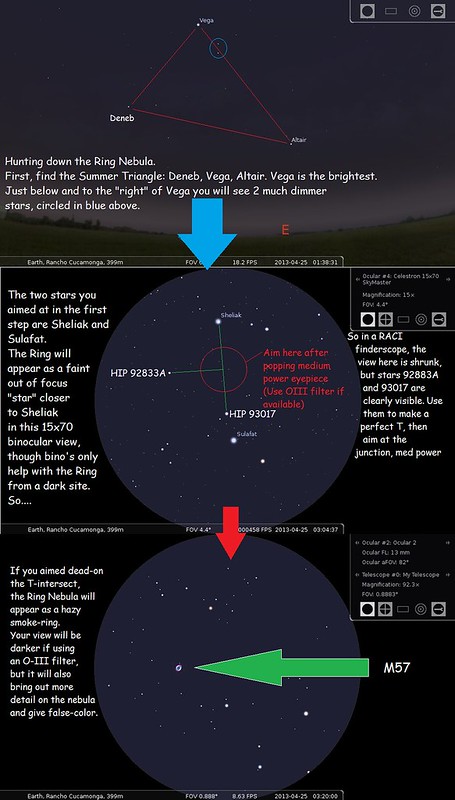
With good transparency and no moon, color (blue/green) may even be detected in the ring. Larger aperture instruments will also reveal the white dwarf visible in the photo above.
Messier 29

Relatively easy to locate, this small cluster, sometimes called the Cooling Tower Cluster, is one of the less notable Messier objects but is one of the easier to locate, not even a binocular FOV from Sadr, the intersection star in the Northern Cross that makes up the bulk of Cygnus the swan.
Messier 39
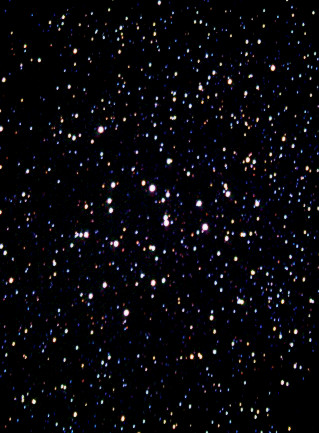
Start at Deneb, and move your binoculars two-fields-of-views-widths north/northeast, until you come across a large equilateral triangle of stars with about two dozen dimmer members, all adrift amid-st a portion of the Milky Way star field. This is open cluster Messier 39, an object too large to really observe with a telescope, and just bright enough to be faintly visible to the naked eye in good conditions.
Messier 56
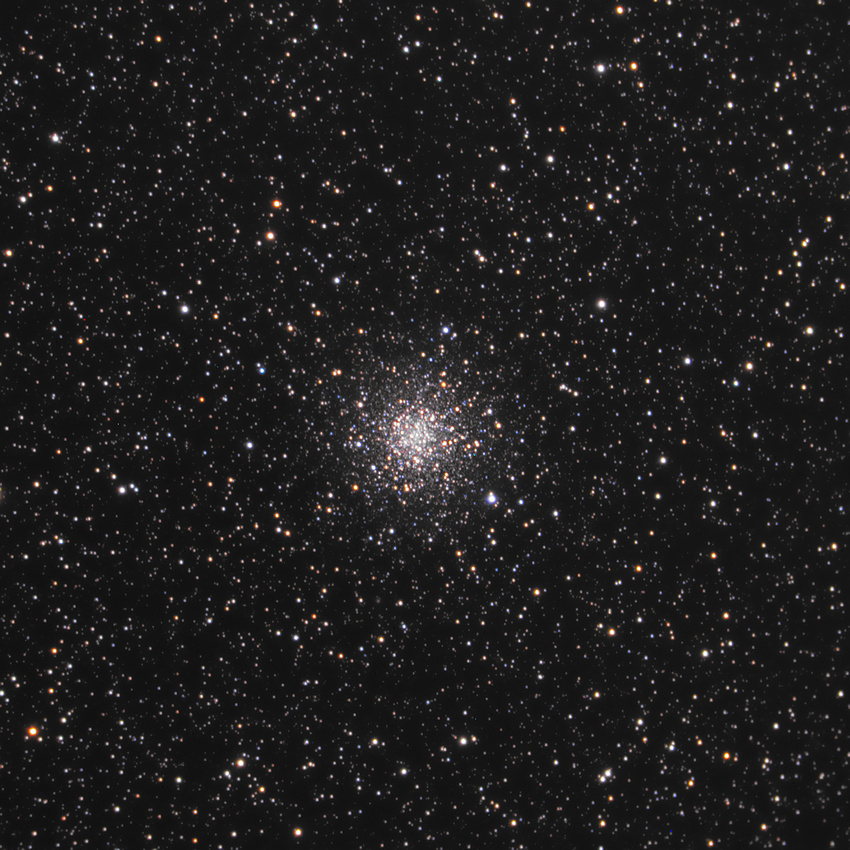
While not a particularly large globular, Messier 56 makes for an interesting image against the plethora of Milky Way stars. Finding it is easy when overhead but as it is still rising at the time of your attempt, here's a star-hop chart from our earlier galaxy guide:

Messiers 10 and 12: Globulars in Ophiuchus
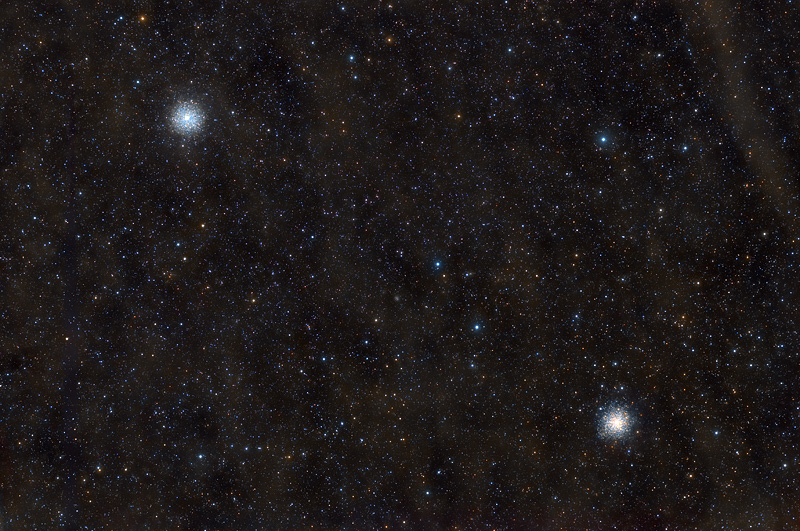
M10 is large and rich, M12 loose and spacious, both easy to resolve in an amateur telescope. Though they appear close together (you can catch them both as fuzzy patches in a finderscope or binoculars side by side), M12 is 5,000 light years further away. Finding them with binoculars or a finder is relatively simple: start at the head of Ophiuchus, Resalhague, and continue in a straight line "south" to Zeta Oph. The globulars will appear about two thirds of the way down, towards Zeta.
3:00AM TO 4:30AM- A Mad Dash
Just before the pre-dawn hours, the Milky Way will appear rising in full glory from the East, and with it, numerous targets stretching south from Cygnus to Sagittarius. The overview map for these can be found here: View image
M27/71/11 findercharts from our Galaxy Guide:

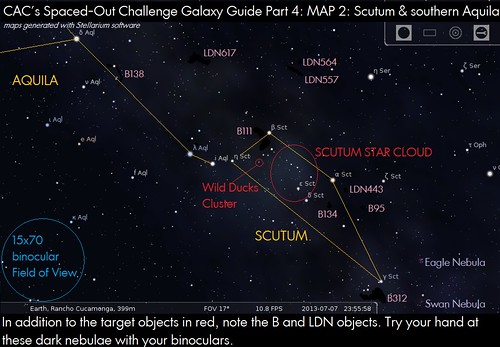

Messier 27: The Dumbbell Nebula
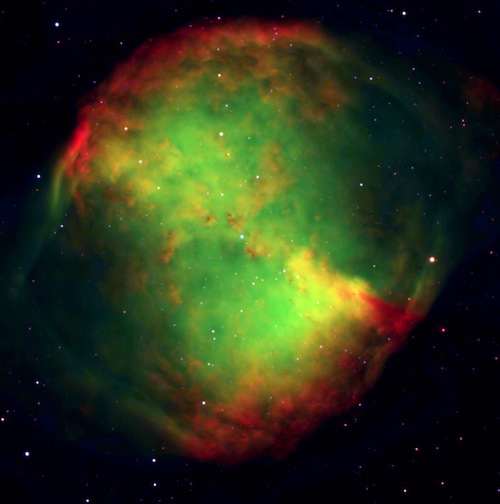
Planetary nebulae are one of the few deep sky objects that, with moderate aperture, appear to the eye as they do before a camera. Some even show color, such as the Blue Snowball. The Dumbbell Nebula is large and bright enough to be peaked at with binoculars:

But really shows itself off through even the smallest telescopes:

Faint greens can be detected with averted vision and aperture of about 6” or larger, and the white dwarf star corpse illuminating it is readily visible.
Messier 71

In binoculars there is little to resolve but it stands out nicely with star 9 Sagitta close by.

In even small telescopes, the core of this is-it-or-isn't-it globular resolves easily.
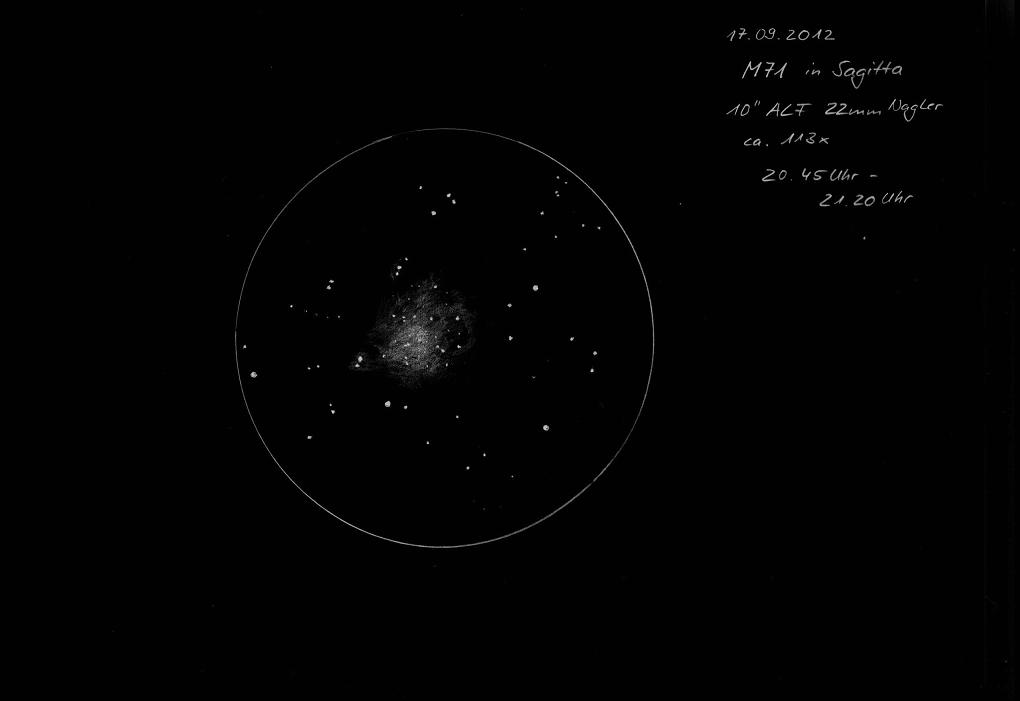
Messier 11: The Wild Ducks Cluster
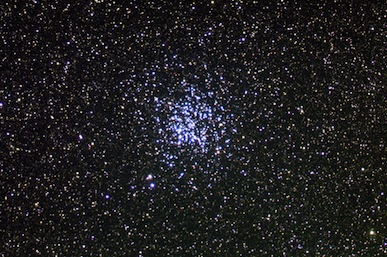
Mid-way between lamda Aquila and alpha Scutum you'll spot a tight concentration of stars in binoculars. With a telescope, this concentration becomes an incredible open cluster with a core of over a hundred stars. It surpasses any open cluster in beauty this side of the border of Cassiopeia and Perseus, and it's namesake is evident at even low-power.

Clusters & Nebulae in Sagittarius- Charts
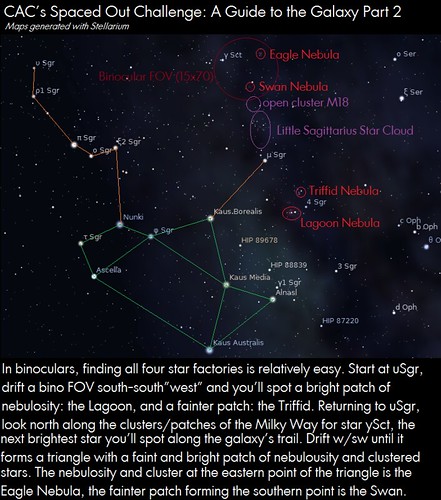

Messier 16: the Eagle Nebula

A beautiful nebula within the Sagittarius-Carina spiral arm, the Eagle, or Star Queen, is more frequently overlooked for the bright cluster of hot young stars within. Indeed, this emission nebulae, visually wispy from dark sites, pops greatly with the aid of a filter, which suppresses the light from the interspersed stars, allowing for the fainter details to sneak through. There are numerous points of interest within, but we're focusing on hunting down our challenge teased at the very beginning, so let's go for it.

A word of caution: patience is required for this challenge. Many amateur astronomers spend years hunting this elusive target. The Cloudy Nights forums have dozens of threads on the subject, the most recent offering some additional tips and tricks here.
All of these objects are best seen on moonless nights from as dark a sky as possible, but this last target, the Pillars, require the darkest of dark. Make sure your vision is protected and avoid all stray light while observing. As mentioned before, a nebula filter is REQUIRED to have any chance of seeing the Pillars, and several are available on Ace's Amazon Store. If you're on a budget, I recommend Celestron's O-III, which may darken the nebula a bit but enhance some of the contrast than a regular UHC filter.
Messier 17: the Swan Nebula

The Swan Nebula (aka the Omega) at the northern end of Sagittarius is another smaller emission nebula, but it's core makes it one of the more striking in the sky. The illusion of a swan drifting across a lake in the stars is plainly visible with an amateur instrument, along with part of the newborn star cluster powering it. The total mass of the nebula is obscured by it's edge-on appearance: at over 30000 times the mass of the sun, it contains nearly 15 times as much material as the Great Nebula in Orion.
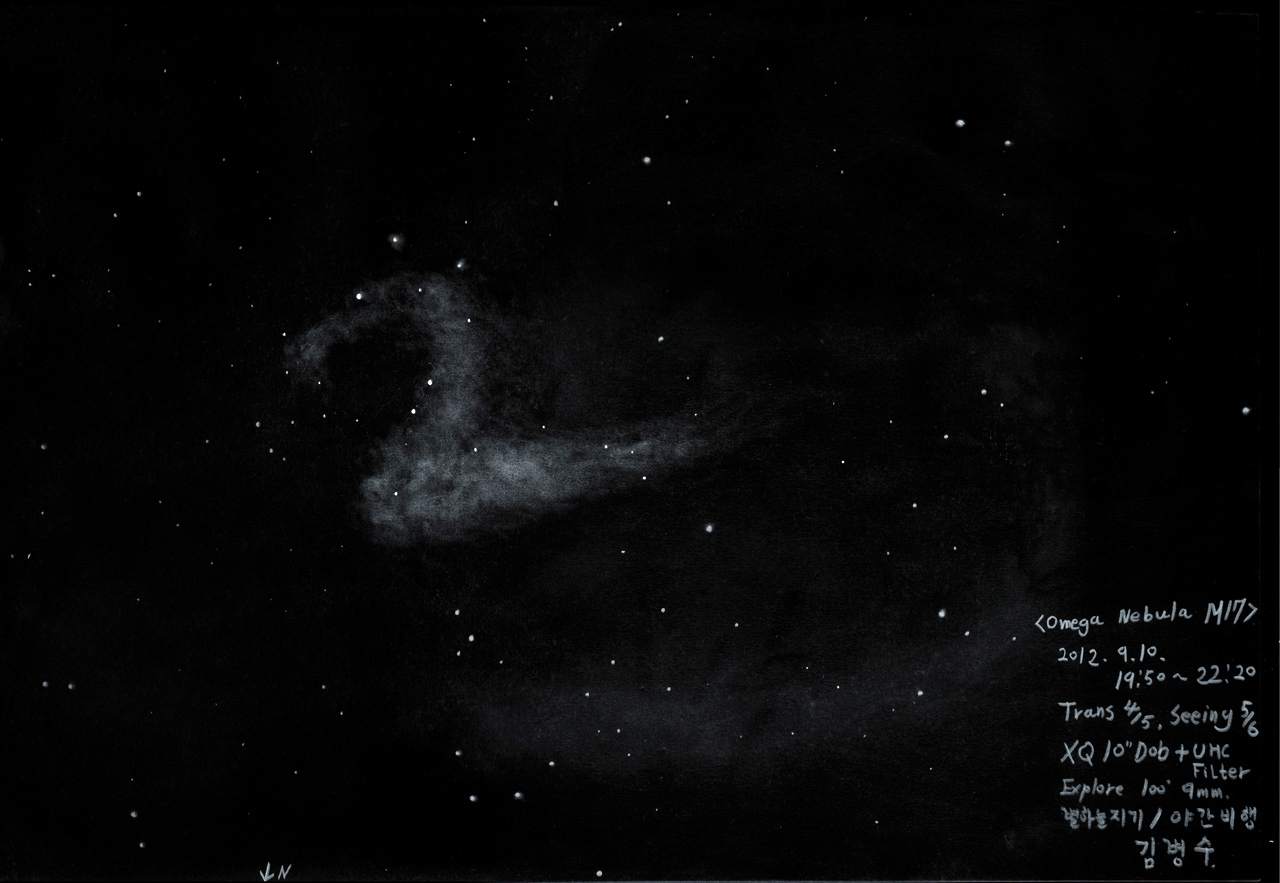
Messier 18

The least distinct of all the open Messier clusters in Sagittarius, it makes a great hop-through point when touring through this portion of the Milky Way. To it's "north" is the Omega and Eagle Nebulae. To it's "south", the Little Sagittarius Star Cluster. Look for a "patch" of about a dozen stars brighter than the background Milky Way field. An interesting note: some researchers claim it is part of a binary pair of clusters, it's sibling being NGC 6618, found inside the Omega Nebula.
Messier 21

Close by the Trifid nebula is a surprisingly small cluster, M21. It's hot stars are also some of the youngest associated with a cluster at just over 4 million years old. In binoculars it makes a nice balance to the intriguing Trifid.
Messier 23

Open cluster Messier 23 is huge, and appears best in binoculars or in a low-power eyepiece through the telescope. This open cluster spans some 30 light years and is unusual in it's lack of diversity in stellar brightness or spectral class. It will appear as a slightly less nebulous patch than the Star Cloud. Some describe it as a “star field” due to it's diffuseness.
Messier 24: the Sagittarius Star Cloud
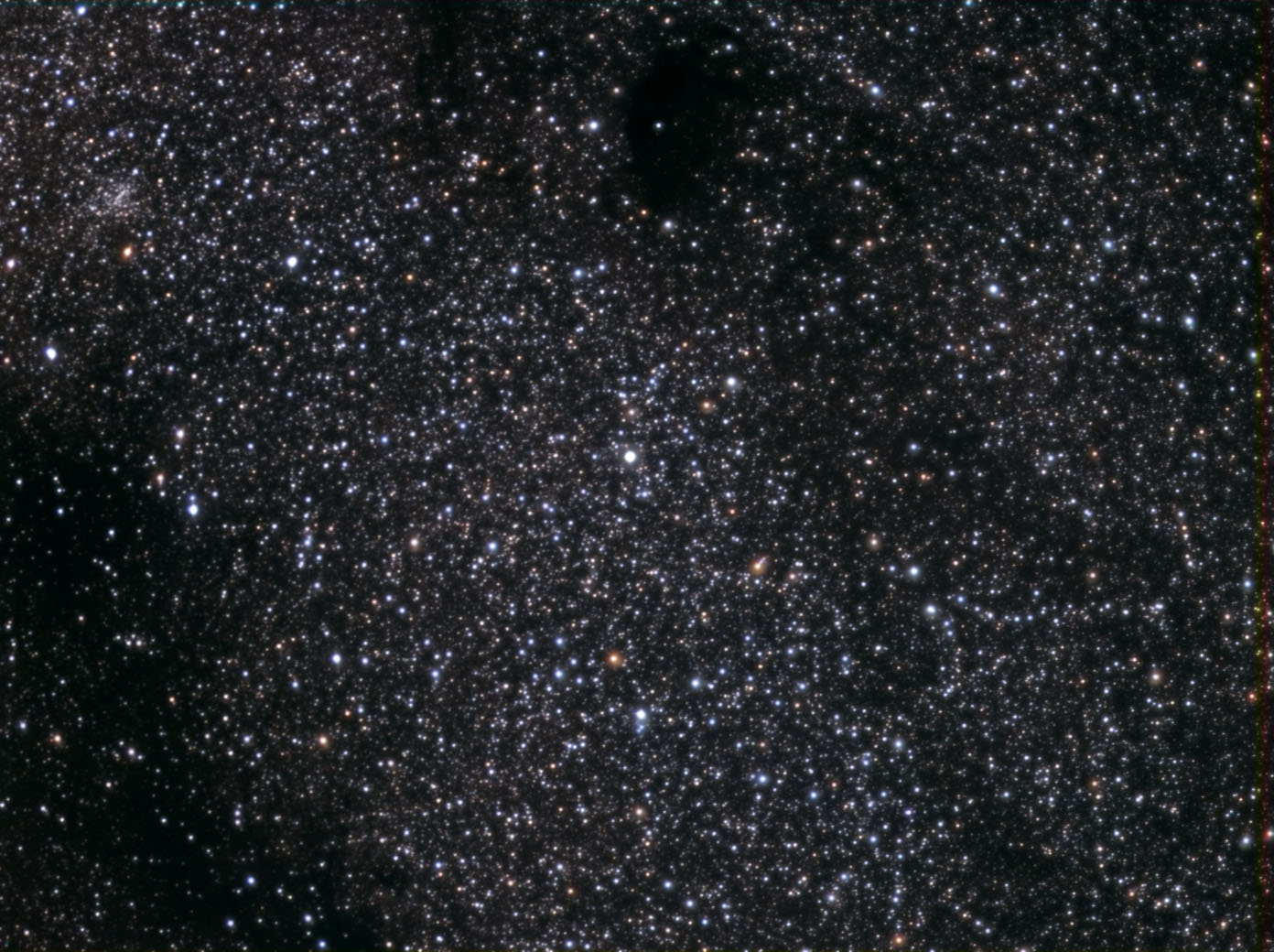
A sizable portion of the inner Sagittarius-Carina arm, M24 is made visible thanks to another "window" through the closer obscuring dust. While concentrated, it's stars are easy to resolve. Aim your binoculars and prepare to get lost in a vast swath of stars pictures fail to justify.
Messier 25

Messier 25 contrasts well with Messier 23, and is located at roughly the same distance from Mu Sagittarius, just in the opposite direction. With a looser appearance, it also enjoys a bit more range in stellar brightness and color.
Messier 22
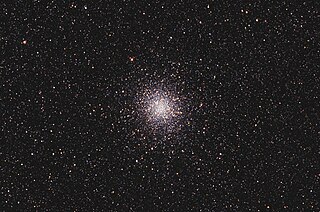
If it was just a bit further north, it would be more well known than the Great Globular in Hercules, being both considerably brighter and larger. The Great Glob of Sag is the third brightest in the sky, behind the massive Omega Centauri and Tucanae 47. It's position leaves it dimmed a bit with the dust and gas of the milky way plane between us, but it's surprising closeness for a globular (only about 10,000 ly away) allows for much of it to clear the galactic fog. An intriguing sight in binoculars, it becomes granular in appearance with even a small telescope.
Messier 20: the Trifid Nebula
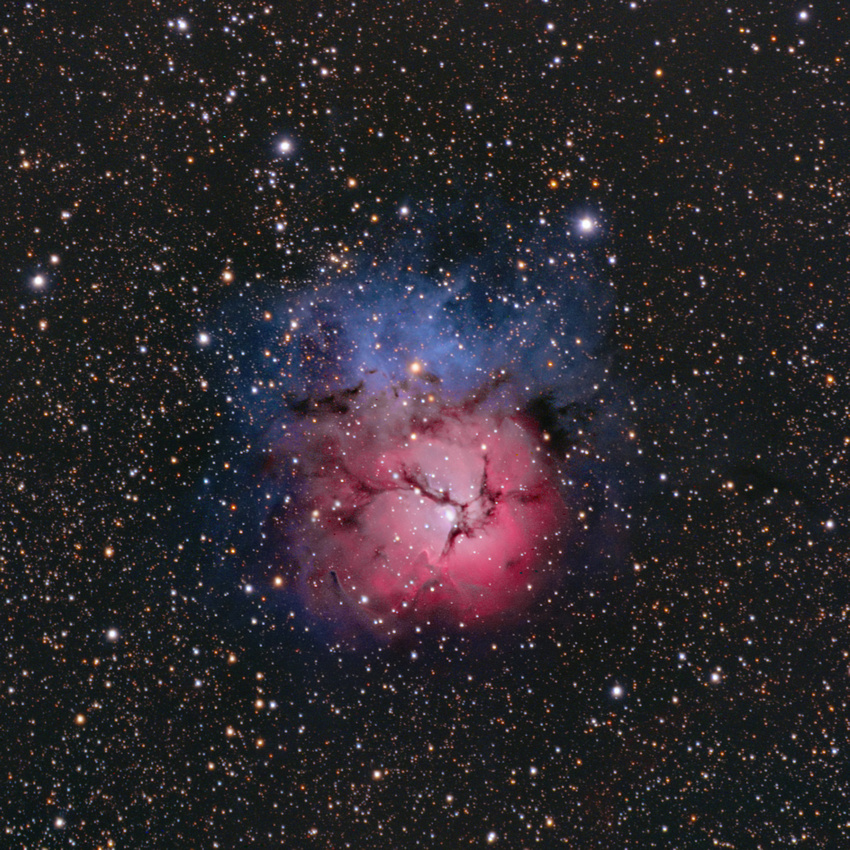
The Triffid Nebula is actually several kinds of nebulae in one: the main portion being an emission nebulae lit up from multistar HN 40, dark nebulae traversing and "dividing" it into its namesake; and a faint reflection nebulae surrounds the main "flower":

The above sketch shows that, as a small but bright nebulae, much detail can be picked up with moderate aperture. The nebulae can be spotted from suburban areas with binoculars, with major detail appearing in telescopes as small as 3".
Messier 8: the Lagoon Nebula

The largest of the four we will discuss, it is also the brightest, and will reveal incredible detail even in suburban skies. Several of the hot young stars it has birthed are naked eye visible and make finding the Lagoon all the easier (see chart).
The nebula is of intense interest in the study of stellar evolution. It contains a number of dark collapsing clouds of protostar material called Bok globules. Even more notable, the first four Herbig-Haro objects were discovered within this nebula. These small patches of nebulosity form when narrow jets of gas ejected by thousand-year-old proto-stars slam into the surrounding embryonic gas and dust, signalling the moment of birth.
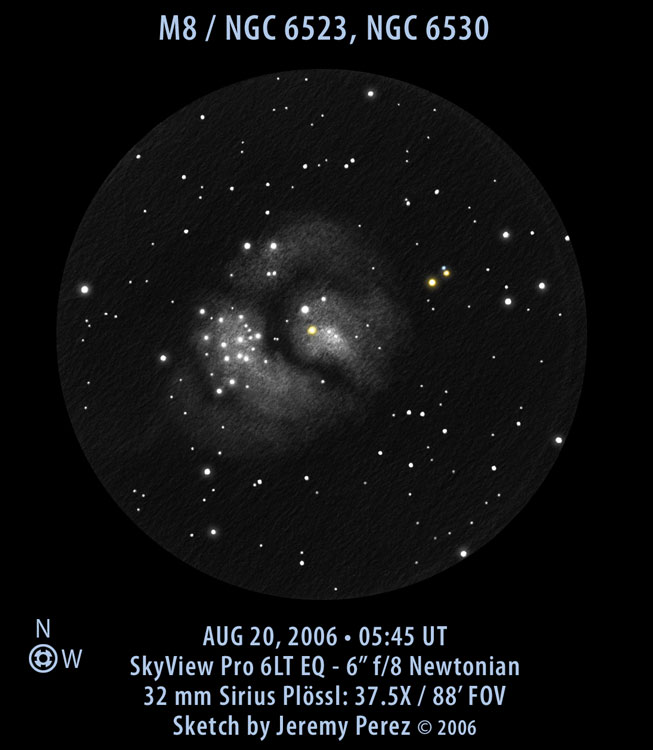
Color isn't visible outside of photographs, but the knots of nebulosity and fantastic contrast is well within reach of amateur telescopes. The hot, bright star cluster eminating from the nebula (NGC 6530) is also a great binocular target.
Messier 7: Ptolemy's Cluster
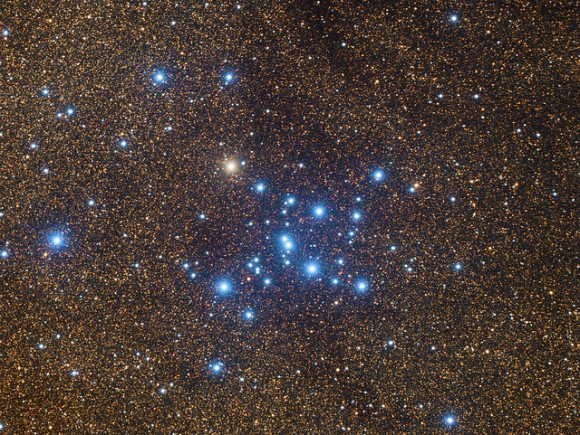
One of the longest-known clusters in the sky, it was first catalogued by Ptolemy almost 2000 years ago as "the nebula following the sting of Scorpius". It is the brighter of the two open Messier clusters in Scorpius, easily visible from all but the most light-polluted sites. A solid dozen stars jump out at you, but a quick peak through binoculars reveals the brilliance and scale of the cluster.
Messier 6: the Butterfly Cluster

Due north west of the bright Ptolemy Cluster is another naked-eye open, slightly smaller but with it's own bit of magic. A collection of mostly blue B type stars (with one bright orange K star exception) about 1600 light years away, historians debate on it's initial "discoverer", as Ptolemy may have lumped it in with the aforementioned cluster as a continuous batch of nebulosity. Regardless who "found" it, it makes for a wondrous target.
Messier 4: the Heart-of-the-Scorpion Cluster
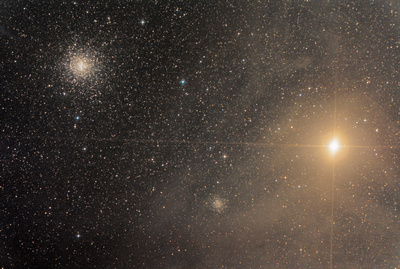
The first globular cluster to be resolved into individual stars, M4 holds many secrets: a millisecond pulsar, more lithium than it's ancient membership would imply, and a truly bizarre double star system: a white dwarf, pulsar, and a gas planet with two-and-a-half-time the mass of Jupiter! M4 is extremely easy to locate from dark skies, barely a degree away from fiery Antares. For better detail, up your magnification until the glare of Antares is no longer evident.
4:30AM to Dawn
The last dash has the fewest targets in our guide, though for the more adventurous among you, M74, M30, and M2 can pose additional challenges as the sky brightens. You can also take the time to go back through Sagittarius (I personally can't get enough of it's nebulae). Easier to catch in the evening while higher in the sky, the clusters of Cassiopeia are attainable given a clear northern horizon just before Dawn. Overview map can be found here: View image
The Cassiopeia W will be turning off and away from the northern horizon before daybreak, and here's a more detailed chart showing both the Messier targets and a few other clusters of interest, if you've nailed all of your other targets with time to spare:

Messier 15
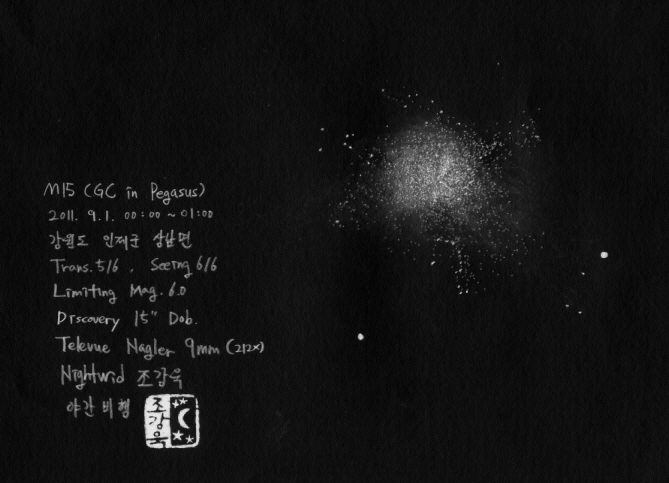
Messier 15 is one of the oldest globular clusters in our galaxy, estimated at 12 billion years, with a collapsed "core" perhaps influenced by a central black hole. In binoculars, its fuzziness teases some granularity, but in telescopes, it begins to really shine, with large Dobsonians resolving its outer regions into individual stars. Finding it requires just a short hop from Biham to Enif, then a hop again half that distance in the same direction. Catching it with your naked eye is one of the indicators of a truly dark site: look for a fuzzy patch just a few degrees from Enif. If you can spot it, congratulations: you have found yourself a truly dark observing site.
Messier 103
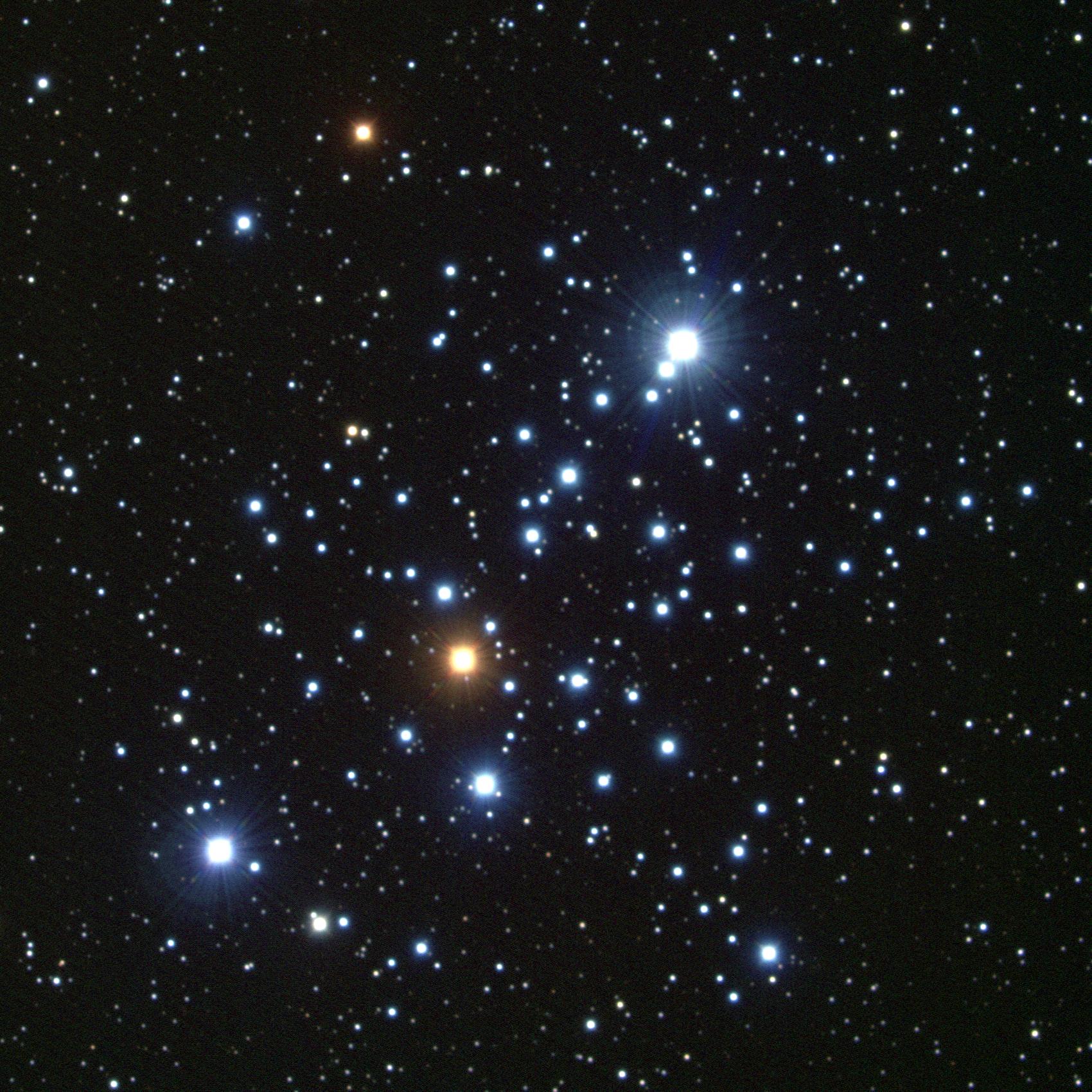
In binoculars, M103 as a nebulous V-shaped patch. In good viewing conditions, binoculars as small as 10x50 can resolve it into individual stars. Beware: nearby NGC 663 is a Messier impostor, with a nearly identical shape to 103. The big tell? NGC 663 will show up well in a finderscope, while the true Messier will not.
Messier 52
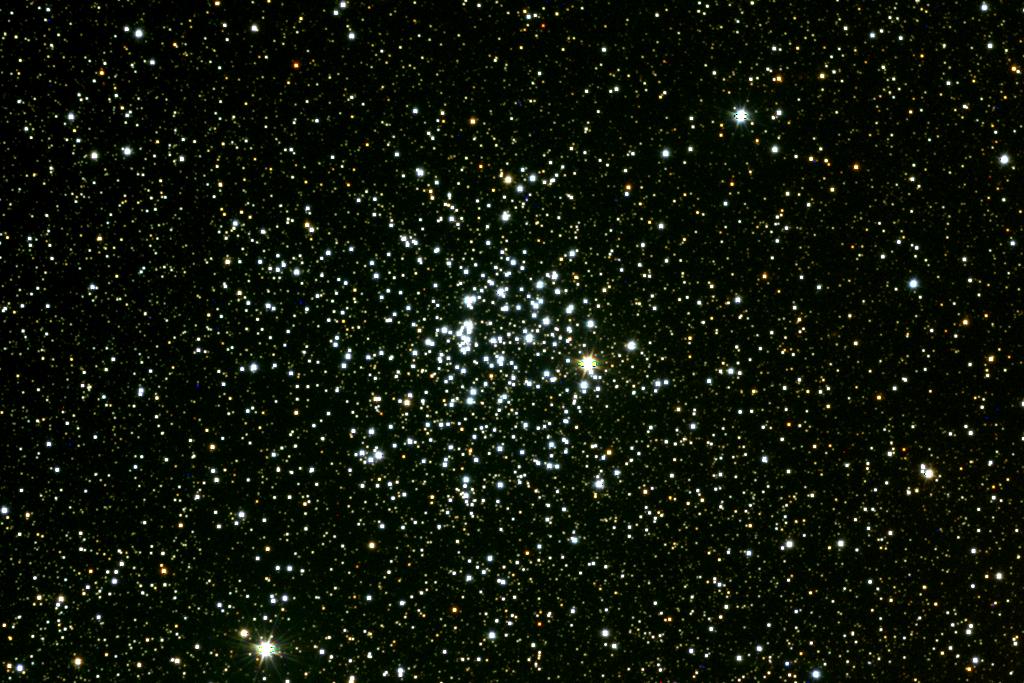
Discovered by Charles Messier in 1774 when a comet skirted past it, Messier 52, superimposed on the Milky Way star field, takes on its namesake in large binoculars and small telescopes. It appears as nebulous patch in good binoculars or through a finderscope. In 4-inch aperture instruments, this rich compressed cluster of faint stars can be fully appreciated, taking on a fan/V shape with a bright yellow star in it's SW edge. Do you notice a needle-shaped inner region?
END OF GUIDE
Odds and Ends
This week, we saw a breakthrough in cosmology with the detection of gravity waves in the cosmic microwave background. The New Scientist has a great video explaining this discovery with just an apple and a towel:
Sky and Telescope's Tony Flanders shares a beautiful morning rendezvous between Venus and a thinning moon, and gives a brief history of Charles Messier in the current edition of SkyWeek:
The full Beginner's Buyer's Guide, our Comet Guide (featuring additional grab-and-go telescopes), and any other edition you're looking for can be found in the master index of all Spaced-Out Challenge threads here, but of course you can always inquire about binoculars, telescopes, and all the rest in the comments. As always, if you have astrophotography, product recommendations, or astronomy news you'd like to see on a future Spaced-Out Challenge, email me at theoneandonlyfinn (at) gmail.com, or tweet me @conartcritic.
If you have any more questions about your new optics, feel free to ask below. Until next time, clear skies to you, and keep looking up!
publius, Rascally Mr. Miley (w6EFb): " This is all about Chyna. The Chicoms are getti ..."
Dr. Claw: "30 'Sharyn is kind of attractive. I thought she'd ..."
tcn in AK: "I was voluntold to become the elevator SME (subjec ..."
rickb223 [/s][/b][/i][/u]: "Surprise: The "Reporter" Who Leaked and Whined Tha ..."
Accomack: "Every Indian tribe lost. They were lucky not to be ..."
Spoiler Alert: "Deeply unhappy Karen complains bitterly about bein ..."
Smell the Glove : "@142 the elites of any society and government vare ..."
ChristyBlinkyTheGreat: "126 For Christmas, I want to see Brown Univ foiste ..."
San Franpsycho: "I mean yes he is. Posted by: Soothsayer at Decemb ..."
Brenda Lee Wants Some Fucken Pie: "Reporters at CBS News are threatening to quit over ..."
Accomack: "Death cults don’t save for a rainy day ..."
Surprise: The "Reporter" Who Leaked and Whined That Her Hit-Piece Got Held Up Turns Out to Have a History of Batty Leftwing Propaganda Pieces
Is This Something?
Communist Cuba "On Edge of Collapse" Due to Trump's Oil Embargo of Cuba's Key Ally Venezuela
Epstein Files Reveal Bill Clinton Cavorting With Very Young Women on Pedo Island; Democrat Flacks and Leftwing Media -- But I Repeat Myself-- Claim Trump Is "Curating" the Photos to Make Slick Willy Look Bad
AGAIN: Violent Deranged Homeless Man, Set Free By Leftwing Judges Over and Over Again, Randomly Slashes and Permanently Blinds a 75 Year Old Woman
Bari Weiss Halts "60 Minutes" Hit Piece on Trump Over Sending Criminal Illegals to El Salvador, Saying Further Reporting and Context is Required; The Left Freaks Out
THE MORNING RANT: As Warner Bros Discovery circles the drain, CEO David Zaslav extracts generational wealth for himself
Mid-Morning Art Thread
The Morning Report — 12/22/25
Paul Anka Haiku Contest Announcement
Integrity SAT's: Entrance Exam for Paul Anka's Band
AllahPundit's Paul Anka 45's Collection
AnkaPundit: Paul Anka Takes Over the Site for a Weekend (Continues through to Monday's postings)
George Bush Slices Don Rumsfeld Like an F*ckin' Hammer
Democratic Forays into Erotica
New Shows On Gore's DNC/MTV Network
Nicknames for Potatoes, By People Who Really Hate Potatoes
Star Wars Euphemisms for Self-Abuse
Signs You're at an Iraqi "Wedding Party"
Signs Your Clown Has Gone Bad
Signs That You, Geroge Michael, Should Probably Just Give It Up
Signs of Hip-Hop Influence on John Kerry
NYT Headlines Spinning Bush's Jobs Boom
Things People Are More Likely to Say Than "Did You Hear What Al Franken Said Yesterday?"
Signs that Paul Krugman Has Lost His Frickin' Mind
All-Time Best NBA Players, According to Senator Robert Byrd
Other Bad Things About the Jews, According to the Koran
Signs That David Letterman Just Doesn't Care Anymore
Examples of Bob Kerrey's Insufferable Racial Jackassery
Signs Andy Rooney Is Going Senile
Other Judgments Dick Clarke Made About Condi Rice Based on Her Appearance
Collective Names for Groups of People
John Kerry's Other Vietnam Super-Pets
Cool Things About the XM8 Assault Rifle
Media-Approved Facts About the Democrat Spy
Changes to Make Christianity More "Inclusive"
Secret John Kerry Senatorial Accomplishments
John Edwards Campaign Excuses
John Kerry Pick-Up Lines
Changes Liberal Senator George Michell Will Make at Disney
Torments in Dog-Hell
The Ace of Spades HQ Sex-for-Money Skankathon
A D&D Guide to the Democratic Candidates
Margaret Cho: Just Not Funny
More Margaret Cho Abuse
Margaret Cho: Still Not Funny
Iraqi Prisoner Claims He Was Raped... By Woman
Wonkette Announces "Morning Zoo" Format
John Kerry's "Plan" Causes Surrender of Moqtada al-Sadr's Militia
World Muslim Leaders Apologize for Nick Berg's Beheading
Michael Moore Goes on Lunchtime Manhattan Death-Spree
Milestone: Oliver Willis Posts 400th "Fake News Article" Referencing Britney Spears
Liberal Economists Rue a "New Decade of Greed"
Artificial Insouciance: Maureen Dowd's Word Processor Revolts Against Her Numbing Imbecility
Intelligence Officials Eye Blogs for Tips
They Done Found Us Out, Cletus: Intrepid Internet Detective Figures Out Our Master Plan
Shock: Josh Marshall Almost Mentions Sarin Discovery in Iraq
Leather-Clad Biker Freaks Terrorize Australian Town
When Clinton Was President, Torture Was Cool
What Wonkette Means When She Explains What Tina Brown Means
Wonkette's Stand-Up Act
Wankette HQ Gay-Rumors Du Jour
Here's What's Bugging Me: Goose and Slider
My Own Micah Wright Style Confession of Dishonesty
Outraged "Conservatives" React to the FMA
An On-Line Impression of Dennis Miller Having Sex with a Kodiak Bear
The Story the Rightwing Media Refuses to Report!
Our Lunch with David "Glengarry Glen Ross" Mamet
The House of Love: Paul Krugman
A Michael Moore Mystery (TM)
The Dowd-O-Matic!
Liberal Consistency and Other Myths
Kepler's Laws of Liberal Media Bias
John Kerry-- The Splunge! Candidate
"Divisive" Politics & "Attacks on Patriotism" (very long)
The Donkey ("The Raven" parody)

